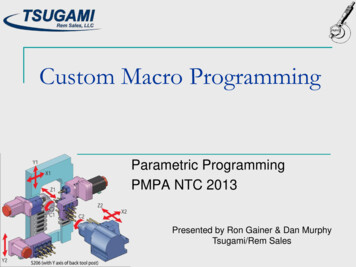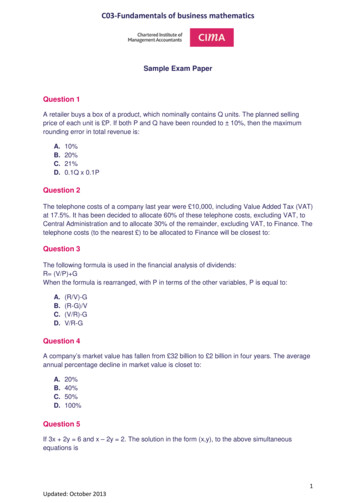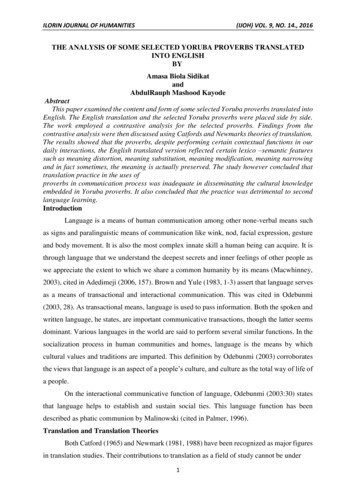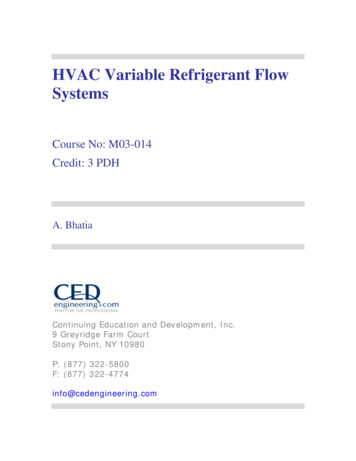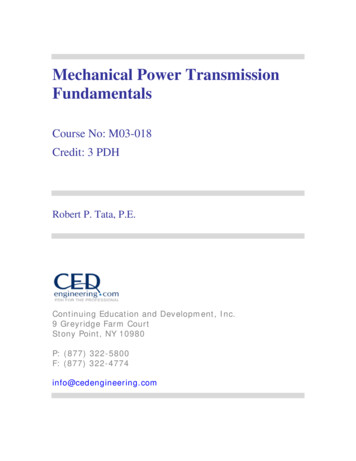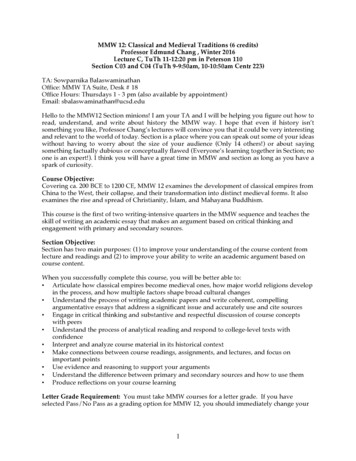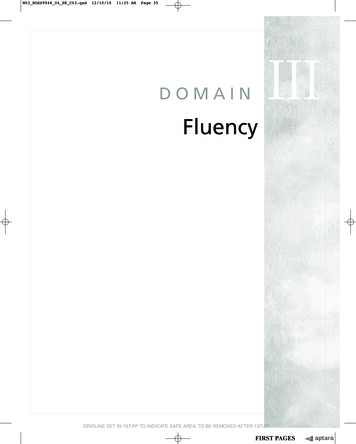
Transcription
M03 ROSS9948 04 SE C03.qxd12/10/1011:25 AMPage 35DOMAINIIIFluencyGRIDLINE SET IN 1ST-PP TO INDICATE SAFE AREA; TO BE REMOVED AFTER 1ST-PP
M03 ROSS9948 04 SE C03.qxd3612/10/10Domain III11:25 AM Page 36FluencyDomain IIISecond Grade GroupMrs. Roberts has 20 students in her second grade class, all from a suburbanneighborhood. All students are motivated to read, regardless of their readinglevel. They enjoy books and going to the library. The teacher is concernedabout a small group of readers who are average readers for their age, butthey are still reading word by word without expression. They have adequateword attack skills; however, they use their fingers to track across the linesof text, which slows their speed. What are this group’s strengths and needs,and what three techniques would you suggest that Mrs. Roberts use toaddress these problems?Make some notes of your own before turning the page.StrengthsNeedsStrategiesGRIDLINE SET IN 1ST-PP TO INDICATE SAFE AREA; TO BE REMOVED AFTER 1ST-PP
M03 ROSS9948 04 SE C03.qxd12/10/1011:25 AMPage 37 Second Grade GroupBrainstorming Response IdeasStrengthsAge-appropriate word attack skillsMotivated to read; enjoy booksNeedsIncreased fluencyExpression when readingStrategiesHave teacher model prosody, such as reading with expression, varying intonation, using meaningful pauses for sense making.Use repeated readings with books on students’ independent level.Have students work with partners to practice, using either choral or echoreading.Have students use book markers instead of finger pointing across the page.Encourage students to use a tape recorder to be able to listen and assesstheir own reading.Use reader’s theater and have students present the finished product to anaudience, possibly utilizing puppets to perform the play.NarrativeAlthough they have adequate word attack skills, they can understand what theyread, and they are motivated to read, this group needs to increase fluency andexpression. The fact that they rely on their fingers to move across a line of textslows them down considerably. The teacher should suggest that they employ amarker in place of using their fingers.In addition, Mrs. Roberts might draw on three techniques to increase prosody.The first technique she could use is to read to the group (or class) and modelprosody: reading with expression, varying the intonation she uses, and usingmeaningful pauses to show how good readers make sense of text.Second, she might have students work in pairs (partner or buddy reading) todo repeated readings of familiar text. They may read the selections chorally or doecho reading, where the partners take turns reading right after the first reader.They may also take turns reading into a tape recorder to be able to listen to and assess his or her own reading. Since this group of students may very well lack confidence in reading, the third technique to promote fluency and expression in herstudents’ reading is to have the group do a reader’s theater in which studentsrewrite a book or story in play form. Mrs. Roberts can then have students presentthe finished product to an audience, possibly utilizing puppets to perform the play.This practice allows practice in a fun, motivating way.GRIDLINE SET IN 1ST-PP TO INDICATE SAFE AREA; TO BE REMOVED AFTER 1ST-PP37
M03 ROSS9948 04 SE C03.qxd3812/10/10Domain III11:25 AM Page 38FluencyThird Grade GroupThis third grade class is in a Title I school. The students in the class exhibita variety of skill and ability levels. Just a few are still struggling with English.Although the parents are generally very supportive of the school, few ofthese children are read to at home. The class enjoys read-alouds by theteacher, and they respond well to the stories through discussion. Four students are in the emergent reader stage; they know many sight words, butthey read word by word, so their oral reading is laborious.However, they do enjoy independent reading when they get to look ator read simple books. Results of a reading and phonics analysis show thatthey recognize almost all initial consonant sounds and use those to guesswords, buy they ignore medial vowels and ending consonants. State twostrengths and two needs of this group, and discuss two instructional strategies you would provide for these students.Make some notes of your own before turning the page.StrengthsNeedsStrategiesGRIDLINE SET IN 1ST-PP TO INDICATE SAFE AREA; TO BE REMOVED AFTER 1ST-PP
M03 ROSS9948 04 SE C03.qxd12/10/1011:25 AMPage 39 Third Grade GroupBrainstorming Response IdeasStrengthsKnow most sight wordsKnow almost all consonant soundsHave an interest in readingHave comprehension of text when listening to read-aloudsNeedsAutomaticity in word attack and sight words to promote fluency and comfortwith readingStrategies for monitoring reading and self-correction of miscuesStrategiesAdd think-alouds to read-alouds, where the teacher models how good readersprocess text as they read.Based on needs, give explicit, systematic instruction in phonics with emphasison word families and common word patterns.Create activity centers that give students practice in phonics skills and previously taught generalizations.Put up word walls that contain the most frequently used words so that studentscan refer to them when writing.Use sight words from the word wall to have students make cards that containthe words that he or she is struggling with; students can review the cardseach day and practice using visual, auditory, kinesthetic, and tactile modes(VAKT) so that the student sees the word, listens to the sounds in the word,writes the word, and then traces each letter with a finger to get the “feel” ofthe word.Have individual student-made dictionaries.Give opportunities to apply phonic skills using contexts such as languageexperience stories, decodable text, and other simple books.Give direct instruction in strategies for monitoring and self-correction inreading—for example, using picture and context clues to support phoneticelements.Give many opportunities to do choral reading with the students to promoteword recognition and fluency using poems and plays.For repeated practice, send books home that students have already read andhave them practice with their families.NarrativeThis third grade group has some relative strengths in the areas of knowledge of initial consonants and sight words. They also have good listening comprehension anddisplay an interest in reading. However, they are still in need of decoding strategiesGRIDLINE SET IN 1ST-PP TO INDICATE SAFE AREA; TO BE REMOVED AFTER 1ST-PP39
M03 ROSS9948 04 SE C03.qxd4012/10/10Domain III11:25 AM Page 40Fluencyinvolving medial vowels and ending consonants and of a larger cadre of sightwords. Therefore, because their reading is laborious, their greatest need is in thearea of fluency. This problem stems from a lack of automaticity in word recognition, which includes phonic skills and sight words or high frequency words, as wellas a lack of monitoring and the use of context clues.By the third grade, if this group has had a continuous phonics program fromthe beginning of their schooling, instruction in phonics should emphasize wordpatterns and word families rather than individual phonemes. This approach stillutilizes systematic, direct instruction in phonics but focuses on word patterns(e.g., j/ack, t/ ack, sh/ack). The teacher can then create activity centers that givestudents practice in phonics skills and previously taught generalizations.To address the lack of sight words, put up word walls that contain the most frequently used words so that students can see them every day. For further practice,students can use sight words from the word wall to make flash cards of the wordsthey do not know.Students can then review the cards each day and practice using visual, auditory, kinesthetic, and tactile modes (VAKT) so that the student sees the word,listens to the sound in the word, writes the word, and then traces each letter witha finger to get the “feel” of the word. This practice greatly increases the chancethat the student will get the words into memory. Students need many opportunities to apply phonics skills using contexts such as language experience stories,decodable text, and other simple books.Another way that the teacher can increase fluency is to add think-alouds toread-alouds, with the teacher modeling how good readers process text as theyread. This could include modeling the use of context clues and self-correction ofmiscues (errors) in particular; then the teacher could follow up with directinstruction in context clues. Specifically, teach students to check their reading tosee whether the word they have inserted makes sense in the context of the sentence, and correct it if it doesn’t. This should also be followed by extensive practice in the use of context clues under the direction of the teacher.After instruction in word attack and context clues, the teacher would need toprovide multiple opportunities for this group to practice fluency. Besides usingrepeated readings, doing choral reading is another excellent way to help readersfeel what it is like to read fluently. The materials for choral reading can includepoems and plays in addition to language experience stories and simple books. Forrepeated practice in reading, the teacher can send home books that students havealready read and have them practice with their families.GRIDLINE SET IN 1ST-PP TO INDICATE SAFE AREA; TO BE REMOVED AFTER 1ST-PP
M03 ROSS9948 04 SE C03.qxd12/10/1011:25 AMPage 41 Answers to Multiple-Choice QuestionsMultiple-Choice QuestionsQuestion 1Billy, Ramon, Ahmed, and Natasha, all fourth graders, stopped reading when theymet the following words: “photosynthesis,” “osmosis,” “cytoplasm,” “endoplasmic,”“mitochondria.” Which of the following skills do you think would help them themost with fluency?a) dictionary skillsb) phonemic awarenessc) rules of syllabicationd) structural analysisQuestion 2Which one is not a key indicator of reading fluency?a) accuracyb) ratec) prosodyd) scaffoldingQuestion 3Which two factors can disrupt fluency?a) automaticityb) lack of background knowledgec) complex syntactic structuresd) morphemese) a and bf) b and cg) c and dQuestion 4Mrs. Lee has a fifth grade group; her assessment determined that they have fluencyproblems. Which of the following would not be an effective strategy for Mrs. Lee touse to increase their fluency?a) having the students point to each word as they readb) having them do repeated readings of the same textc) increasing speed of word recognitiond) implementing daily independent reading time (sustained silent reading[SSR] and Drop Everything and Read [DEAR])Answers to Multiple-Choice QuestionsQuestion 1The answer is d) structural analysis. Although c) rules of syllabication is a smallstep toward fluency, it does not always contribute to the understanding of theGRIDLINE SET IN 1ST-PP TO INDICATE SAFE AREA; TO BE REMOVED AFTER 1ST-PP41
M03 ROSS9948 04 SE C03.qxd4212/10/10Domain III11:25 AM Page 42Fluencyconcept. Fluency without comprehension is not reading. And a) dictionary skills isa viable avenue for word definitions but is a practice that is disruptive to the flowin reading. Also, b) phonemic awareness doesn’t apply at the point where readersare at a higher level.Question 2The answer is d) scaffolding, which is a support strategy for comprehension.Answers a, b, and c are key indicators of reading fluency.Question 3The answer is b) lack of background knowledge and c) complex syntactic structures. Answer a) automaticity actually supports fluency, and d) morphemes, unitsof meaning, neither supports nor hinders fluency.Question 4The answer is a) having the students point to each word as they read becauseby the time students are in the fifth grade, they should have stopped pointing toeach word. This practice actually retards fluency. The other strategies all enhancespeed and fluency: By having them do repeated readings (answer b), they will beable to experience what fluency “feels” like; by helping readers to recognize wordsmore quickly, they increase automaticity (answer c); and by having students readdaily and use books at their independent level (answer d), they can only get betterat reading and fluency.GRIDLINE SET IN 1ST-PP TO INDICATE SAFE AREA; TO BE REMOVED AFTER 1ST-PP
echo reading, where the partners take turns reading right after the first reader. They may also take turns reading into a tape recorder to be able to listen to and as-sess his or her own reading. Since this group of students may very well lack confi-dence in reading, the third technique to promote fluency and expression in her
